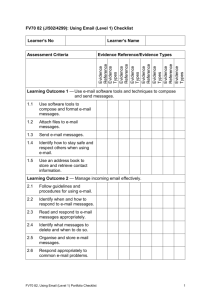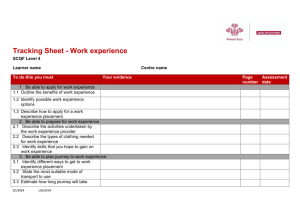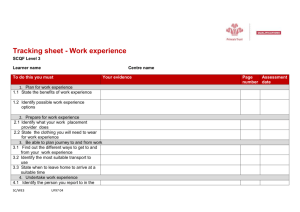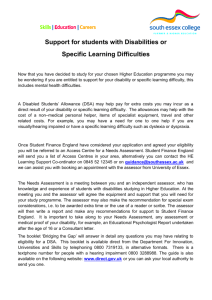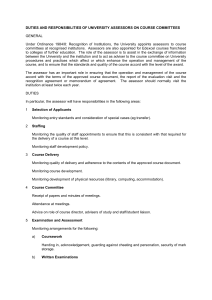Direct Observation Tools Development Guide
advertisement
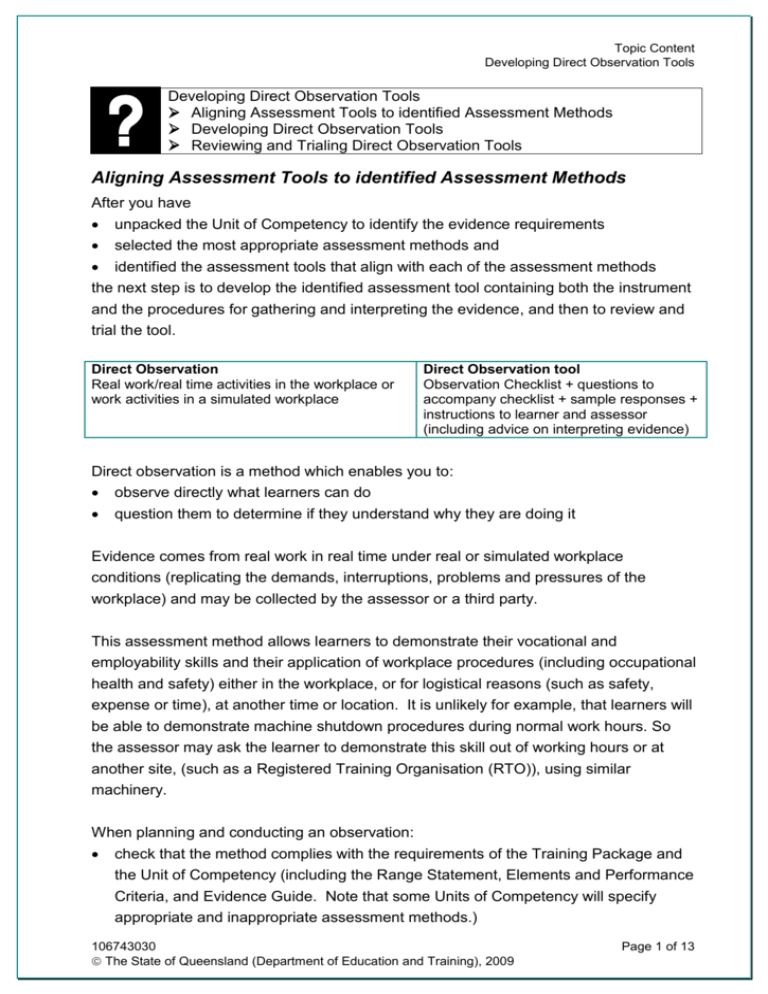
Topic Content Developing Direct Observation Tools Developing Direct Observation Tools Aligning Assessment Tools to identified Assessment Methods Developing Direct Observation Tools Reviewing and Trialing Direct Observation Tools Aligning Assessment Tools to identified Assessment Methods After you have unpacked the Unit of Competency to identify the evidence requirements selected the most appropriate assessment methods and identified the assessment tools that align with each of the assessment methods the next step is to develop the identified assessment tool containing both the instrument and the procedures for gathering and interpreting the evidence, and then to review and trial the tool. Direct Observation Real work/real time activities in the workplace or work activities in a simulated workplace Direct Observation tool Observation Checklist + questions to accompany checklist + sample responses + instructions to learner and assessor (including advice on interpreting evidence) Direct observation is a method which enables you to: observe directly what learners can do question them to determine if they understand why they are doing it Evidence comes from real work in real time under real or simulated workplace conditions (replicating the demands, interruptions, problems and pressures of the workplace) and may be collected by the assessor or a third party. This assessment method allows learners to demonstrate their vocational and employability skills and their application of workplace procedures (including occupational health and safety) either in the workplace, or for logistical reasons (such as safety, expense or time), at another time or location. It is unlikely for example, that learners will be able to demonstrate machine shutdown procedures during normal work hours. So the assessor may ask the learner to demonstrate this skill out of working hours or at another site, (such as a Registered Training Organisation (RTO)), using similar machinery. When planning and conducting an observation: check that the method complies with the requirements of the Training Package and the Unit of Competency (including the Range Statement, Elements and Performance Criteria, and Evidence Guide. Note that some Units of Competency will specify appropriate and inappropriate assessment methods.) 106743030 The State of Queensland (Department of Education and Training), 2009 Page 1 of 13 Topic Content Developing Direct Observation Tools ensure materials, equipment, procedures and conditions reflect current industry practice focus on the whole workplace task rather than separate components set realistic expectations (eg time limits and quality specifications) consider work cycles and situations so that the observation produces reliable evidence and does not interrupt normal routines supplement observation with questioning or an interview, to draw out the way in which underpinning knowledge, employability skills and the dimensions of competency are being applied in practice consider other people in the work environment, such as customers and supervisors who can confirm that observed performance is consistent (not just produced for the assessment situation) share the criteria upon which the assessment is based with the learner and relevant others remember that the learner might feel nervous while being observed use a checklist and predetermined questions to: o help focus on key aspects of the work activity or skill o record that the learner has performed all required tasks There are situations where it might not be possible or it may be inappropriate to use observation. These could include: work activities that occur irregularly, take place over an extended period of time or are difficult to observe (eg dealing with an emergency situation, planning a process or managing a team task) work activities that involve issues of privacy and confidentiality (eg counseling, providing feedback to team members on work performance, or dealing with confidential or private client information) situations where it may be culturally inappropriate to observe the activity situations where the presence of an observer may compromise workplace safety 106743030 The State of Queensland (Department of Education and Training), 2009 Page 2 of 13 Topic Content Developing Direct Observation Tools Developing Direct Observation Tools Assessment Tool(s) When you decide to use Direct Observation, your assessment tool will need to include: An observation checklist Questions to accompany the checklist Supporting documentation: o Sample responses o Instructions to learner o Instructions to the assessor including advice on interpreting the evidence The instrument/s and procedures used to gather and interpret evidence of competence: (a) Instrument – the specific questions or activity used to assess competence by the assessment method selected. An assessment instrument may becomponent supported of bythe a tool development and the RTO’s continuous An important profile of acceptable improvement process is to: performance and the review the tool with other and trial the tool with sample learners prior to decision making rules assessors or useguidelines to be used by assessors. evaluate the effectiveness of the tool following use (b) Procedures – the information or instructions given to the tools are provided on the following pages. Please note Excerpts of Direct Observation candidate and these are provided asthe samples used by assessors NOT as “best practice” exemplars. assessor about how the assessment isChecklist to be The Observation conducted and recorded. An observation (AQTF) checklist: enables focussed observation is based on workplace tasks and written in workplace language (it is not a re-iteration of the elements and performance criteria from the Unit of Competency) incorporates room for structured notes that can be referred to when making the assessment decision or giving feedback to learners provides a prompt for the assessor and a guide for the learner. The complexity of the checklist will mirror the complexity of the task/s being observed. Questions to accompany the Checklist Observation checklists are supported by a list of performance questions which allow the assessor to gather evidence in relation to the learner’s understanding of the task which the assessor is observing. In addition to the task skills which are observed during the activity, these questions assist the assessor to gather evidence in relation to the dimensions of competency: contingency management skills (what would you do if…?) job role / environment skills (what are the procedures and policies for…?) 106743030 The State of Queensland (Department of Education and Training), 2009 Page 3 of 13 Topic Content Developing Direct Observation Tools task management skills (how did you prepare for this task, how do you manage when …?) Questions can also focus on the learner’s confidence to transfer skills to other situations. The questions may be incorporated into the observation checklist or be provided as an additional document. 106743030 The State of Queensland (Department of Education and Training), 2009 Page 4 of 13 Topic Content Developing Direct Observation Tools Transport and Distribution Cluster Learner Name: Assessor Name: Unit/s of competency Workplace Task Assist team member shift materials using mobile crane TDTD197A Shift materials safely TDTE897A Process workplace documents TDTF197A Follow occupational health and safety procedures TDTF297A Conduct housekeeping activities TDTG197A Work effectively with others TDTI297 Apply customer service skills Date of Assessment Location Procedure to be observed: Observation of the learner assisting in mobile crane operations, including the setting up and dismantling of the crane, stowing and maintenance of gear, housekeeping of crane and lifting site and assistance in lifting operations. PERFORMANCE During the activity did the learner satisfactorily: follow OHS procedures related to the operation of a mobile crane under close supervision? assist with housekeeping procedures on both the vehicle and the lifting site? assist with the setting up and dismantling of the mobile crane? assist with the transport and operation of the mobile crane? work effectively within the mobile crane team? carry out the required calculations accurately Yes No Comments apply customer service procedures and policies when dealing with clients? RESPONSES TO QUESTIONING (Satisfactory response – Yes No ) Q1: What are the procedures and policies for housekeeping in a mobile crane vehicle depot and lifting site? Response: Q2: What are your responsibilities in applying them? Response: 106743030 The State of Queensland (Department of Education and Training), 2009 Page 5 of 13 Topic Content Developing Direct Observation Tools Q3: What are your functions when you assist with the setting up and dismantling of mobile cranes? Response: Q4: What would you do if you started to feel tired while you were assisting in the setting up and dismantling of a mobile crane? Response: Q5. What would you do if you found that the crane or lifting gear was defective or faulty? Response: Q6. What would you do if a customer complained to you about an aspect of a lifting job on which you were working? Response: OVERALL THE LEARNER’S PERFORMANCE WAS: Satisfactory Not Satisfactory Feedback to learner: Learner’s Signature: Assessor/Observer’s Signature: Adapted from Designing assessment tools for quality outcomes in VET WA DET 2008 106743030 The State of Queensland (Department of Education and Training), 2009 Page 6 of 13 Topic Content Developing Direct Observation Tools Practical Assessment - AURT210170A (The assessor chose to develop questions to determine underpinning knowledge as a separate document – they are not included in this example) Learner Name: Unit of Competency Code: AURT210170A Unit of Competency Name: Inspect and Service Braking Systems Unit Descriptor This unit identifies the competence required to carry out the service of hydraulic, mechanical, and power assisted (if applicable) braking systems and their associated components Workplace or RTO: RTO workshop Observation: During the demonstration of skills, did the learner satisfactorily complete the following tasks: Not Satisfactory Satisfactory Instructions for demonstration: The apprentice will demonstrate the correct technique and method for Inspecting and servicing braking systems. The teacher will assess the demonstration and provide feedback to the student. Use manufacturers’ workshop manual/publication/database: to access, interpret and apply information/specifications safely use hand and power tools and equipment, observe safety procedures Inspect hydraulic brake system for correct operation and serviceability eg leaks, spongy lever, brake drag smooth lever operation and correct freeplay fluid condition and selection of replacement fluid depending on application stop light operation and adjustment if applicable brake discs/rotors for correct run-out and thickness brake pads for serviceability calliper operation Inspect mechanical brake system for correct operation and serviceability correct cable free play adjustment cable condition and smooth operation shoe actuating camshaft in backing plate for smooth operation determine by adjustment and operational action if further action is required eg shoe,drum or cable replacement correct stop light operation and adjustment correct twin leading shoe adjustment (if applicable) Note: A basic knowledge of hydraulic principles, mechanical lever principles, and the possible causes of vapour lock, brake fade spongy or pulsating lever and brake drag is essential. Comments The student’s demonstration was: Satisfactory Not satisfactory Assessor name: _____________________ Date: / / Assessor signature: _________________________ Excerpt– retrieved from Resource Generator http://www.resourcegenerator.gov.au/ 106743030 The State of Queensland (Department of Education and Training), 2009 Page 7 of 13 Topic Content Developing Direct Observation Tools Supporting Documentation In addition to the Observation Checklist and questions to accompany the Checklist, the assessor must include in the tool: Sample responses Instructions to learners Instructions to assessors and/or observers and advice on interpreting the evidence Sample responses The sample responses (sometimes called marking guides or benchmarks or ghost markers) identify the performance indicators for the task activity and requirements of answers to the knowledge questions. The excerpts below provide examples of how advice to assessors (or other observers) on the required responses can be provided. THCMAN05A: Install LP Gas Systems in Recreational Vehicles Plan and organise activities effectively: Obtain and interpret plans / specifications Determine gas load / design requirements from design drawing or qualified source Calculate storage capacity using recognised formulae or tables acceptable to the relevant State Authority Select capacity which is adequate for the load details given in the job instruction Ensure capacity selected for the application does not exceed requirements given in AG 601 Estimate quantity and type of materials from design drawing or on site dimensions Select materials and components to comply with AG 601 Ensure material quantities ordered are sufficient to complete the installation Ensure materials, equipment, appliance/s and cylinder/s delivered correspond with order form/delivery docket Check materials, equipment, appliance/s and cylinder/s for acceptable condition or report safety hazards encountered while installing an LP gas system. Integrate health, safety and security procedures: Identify and understand staff responsibilities with regard to safe working practices with petroleum Understand and describe characteristics of petroleum products Identify and understand the nature and characteristics of LPG Follow safe application and handling procedures of LPG Follow emergency procedures in the case of an LPG leak explosion or fire Identify application for portable extinguishing equipment correctly Identify HAZCHEM, HAZMAT signage Use personal protective equipment in accordance with OH&S requirements Use manual lifting and handling equipment/techniques in accordance with OH&S requirements …….(continues) Excerpt from Suggested Assessor Checklist – retrieved from Resource Generator http://www.resourcegenerator.gov.au/ 106743030 The State of Queensland (Department of Education and Training), 2009 Page 8 of 13 Topic Content Developing Direct Observation Tools SIRXCLM001A Organise and Maintain Work Area Marking guide and comments The marking guide provides a range of acceptable and expected responses. This guide is not exclusive as individual work environments may give the learner the opportunity to provide other acceptable responses. As the assessor you will need to make a professional judgement on these responses as there may be occasions when not all responses are appropriate and this will require you to have an understanding of the store’s policies and procedures. Learner name Workplace Assessor name Ob=Observation (Observed directly by assessor) ; Per=Performance (May be scenario, role play, etc) Did the Student apply store policies to: (Tick Ob column if able to demonstrate) Maintaining safe, uncluttered, clean and tidy work areas, including where applicable: counters fixtures Ob Marking guide and Comments Dust, clean, wipe, spray, put pens etc. away, maintain supplies of rolls etc., maintain impulse or counter stock, clear returned stock, check equipment, check cords are safe, remove rubbish, remove hazards Comments Face up, recovery, remove damaged stock, remove out of date stock, rotate stock, clean fixtures, check condition of fixtures, remove waste, report and/or remove hazards Comments sinks Clean, spray and wipe, tidy up, put away, empty bins, remove food scraps, report and/or remove hazards Comments storage areas Remove waste, report or remove hazards, check condition of stock, check condition of fixtures, keep walkways clear Comments …….(continues) Excerpt from Suggested Assessor Checklist – retrieved from Resource Generator http://www.resourcegenerator.gov.au/ 106743030 The State of Queensland (Department of Education and Training), 2009 Page 9 of 13 Topic Content Developing Direct Observation Tools Instructions to learners As part of the assessment tool the assessor must provide clear instructions to learners so that they know exactly what is expected of them. These instructions may be written as part of the checklist or included as a separate document (sometimes called an Assessment Cover Sheet or Assessment Criteria Sheet) Good assessment instructions: identify the tasks which are to be performed, are comprehensive covering the who, what, when, where and how of the assessment situation (eg materials required, time frames, assistance available, specific location) are aligned to the correct AQF level are written in plain English using standard industry terminology Example: Instructions to learners: The assessment for this unit requires you to answer a series of questions to test your knowledge and to be observed by your assessor in the workplace. The skills and knowledge to be assessed are described in the assessment Matrix in your Learner Guide, and in the Learner Log or Supervisor Checklist in your Training Record Book for this unit. Your workplace supervisor is required to complete and sign the Workplace Supervisor’s Third Party Report. These assessment activities are detailed below: 1. Observation You will be observed by your assessor as you apply knowledge and skills relating to using tools, chemicals and equipment for the safe and efficient cleaning and maintenance of work areas. The Observation / Performance Checklist will be used. 2. Verbal or Written Questions as appropriate to the assessment context or learner needs You will be asked a series of questions by your assessor to assess your underpinning knowledge. The Questioning Checklist (written or verbal) will be used. 3. Workplace Supervisor verification Verification by a workplace supervisor that the tasks have been completed satisfactorily. The Workplace Supervisor Checklist will be used. …….(continues) Retrieved from Resource Generator http://www.resourcegenerator.gov.au/ 106743030 The State of Queensland (Department of Education and Training), 2009 Page 10 of 13 Topic Content Developing Direct Observation Tools Instructions to assessors Assessors need advice on how to use the observation checklist and how to interpret the evidence provided when making a decision of satisfactory / not satisfactory. Reliability is enhanced when clear instructions to assessors /observers are provided so that they know what resources are needed to be prepared for the assessment activity exactly what they are looking for in relation to learner responses any other issues that need to be taken into account The excerpts below provide advice to assessors in two different vocational areas: Example: Manufactured mineral products Training Package Introduction This advice is based on the following design assumptions: assessors will meet all the requirements as defined in the assessment guidelines assessors will have access to, and use the Training Package as part of their assessment process assessors will contextualise these templates to suit the particular assessment situation while these templates necessarily are for individual units of competency, assessors are encouraged to develop combined assessment tools which will enable integrated assessment of more than one unit of competency concurrently the candidate should be able to describe/explain their actions as they demonstrate a competency – ie answer the question ‘what are you doing/why are you doing it? Reasonable Adjustments and Accommodations in Assessment (In accordance with current Disability Discrimination legislation and standards) Reasonable adjustments for assessment may include, but are not limited to the provision of: specialized equipment and resources eg adaptive technology, assistant devices and equipment, including applications of emerging technologies, pictorial procedure manuals, symbols, signage and graphical representations support provided by appropriately trained support persons eg. Job Support Officers, notetakers, adaptive communication means which might include services of a communication facilitator or interpreter in certain instances, competency may be demonstrated through consultation with and/or under direction of a nominated person/supervisor such as a workplace mentor. …….(continues) 106743030 The State of Queensland (Department of Education and Training), 2009 Page 11 of 13 Topic Content Developing Direct Observation Tools Example: CUETGE2A Assist with staging This unit applies to assisting with staging that involves a variety of floors and operable pieces. This unit should be assessed at an entertainment event or venue on one or more occasions. Observation Observation is a popular assessment method, because it is direct and authentic. However, it will often need to be supplemented by other forms of assessment to obtain sufficient evidence of all aspects of competence. The assessee will be observed: assisting with preparation for staging assisting with pre-production requirements and technical/dress rehearsals safely operating standard hand and power tools safely using a tallescope, hydraulic lifter and an A-frame ladder tying a variety of knots using swaging tools handling ropes correctly plotting cues in accordance with the sequencing, equipment requirements, timing and speed requirements of a given show carrying out basic set assembly In this unit simulation can be used to assess a wide range of competencies including those listed under “Observation”. …….(continues) Excerpt retrieved from Resource Generator http://www.resourcegenerator.gov.au/ Reviewing and Trialing Direct Observation Tools Before you use your direct observation assessment tools it is important that you review the tools with other assessors and trial them with relevant stakeholders to confirm validity and reliability and to obtain advice on fairness and flexibility. Focus particularly on whether the tools satisfy the needs of learners and the requirements of the unit of competency, if the instructions are clear and if other assessors can reliably use the tools you have developed. Stakeholders could include: trainers other assessors a sample group of learners supervisors / industry representatives language, literacy and numeracy advisors 106743030 The State of Queensland (Department of Education and Training), 2009 Page 12 of 13 Topic Content Developing Direct Observation Tools You can use information provided by the reviewers to target potential problems with the tools and highlight areas for improvement. It is up to you to modify the tools based on their responses and depending on the magnitude of the revisions, you may feel it is necessary to go back to the reviewers to seek further feedback. To demonstrate evidence of continuous improvement it is important to keep a record of the trial/s including: the stakeholders involved their recommendations the revisions you made Don’t forget to maintain version control on your tools to ensure you (and other assessors) use the most current version. Developing Direct Observation Tools Aligning Assessment Tools to identified Assessment Methods Developing Direct Observation Tools Reviewing and Trialing Direct Observation Tools 106743030 The State of Queensland (Department of Education and Training), 2009 Page 13 of 13
